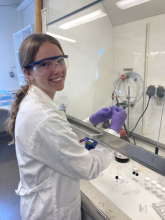
University:
Major:
Site Abroad:
Mentor(s):
Faculty Sponsor(s):
Faculty Sponsor's Department:
Project Title:
Project Description:
For this project, the silicification of lipids in buffer solution was investigated to optimize the fabrication process of thin-film composite (TFC) membranes housing water-transporting proteins. Silicification involves the hydrolysis of a silica precursor, Tetraethyl orthosilicate (TEOS), and the eventual condensation of silica onto a lipid vesicle, forming particles with a core-shell structure. In order to improve the silica condensation process, the optimal ratio between the silica precursor and lipid, TEOS and 1-Palmitoyl-2-oleoyl phosphatidylcholine (POPC) respectively, was determined through a silicification time-study. Additionally, the optimal Tris/NaCl buffer concentration for the process was investigated. First, the TEOS to POPC Lipid ratio was studied over a 6 hour time period using Dynamic Light Scattering to gather particle size and zeta potential data. The optimal ratio was determined to be 8 parts TEOS to 1 part POPC Lipids. This was preferred to 4 parts TEOS to 1 part POPC Lipids as the measurements revealed less aggregation, the optimal case, with the 8 to 1 ratio. Next, Tris/NaCl buffer concentration ratios were tested. Using the same 6 hour measurement model 50mM Tris, 50mM Tris 25mM Nacl, 50mM Tris 50mM NaCl, 50mM Tris 100mM NaCl, and 50mM Tris 200mM NaCl buffer solutions were all tested. The experiment revealed the optimal buffer solution concentrations to be 50mM Tris 200mM NaCl as it produced ideal particle size with minimal aggregation and optimal solution suspension stability. Thus, the ideal components for silicification were determined to be 8:1 TEOS to POPC and 50mM Tris 200mM NaCl buffer. This will improve the time and quality of the silicification process to optimize membrane fabrication for use in water filtration. Future work would include continued testing of buffer solutions containing higher concentrations of NaCl to further assess the effects of buffer concentration on silicification.
